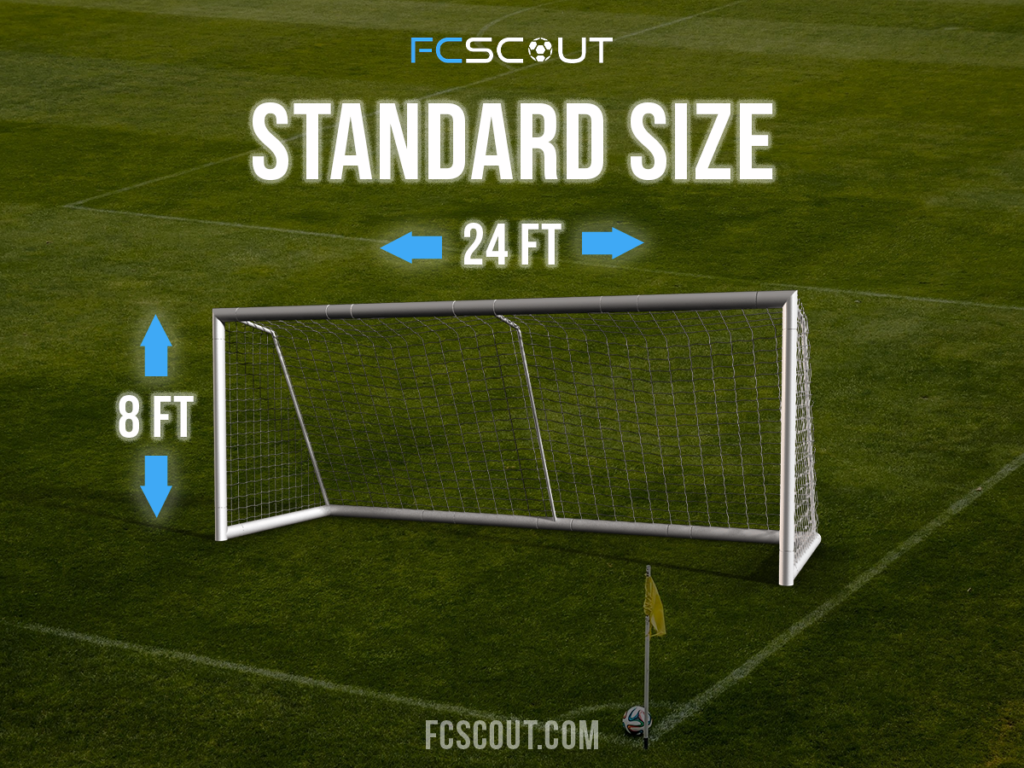Soccer Goal Sizes: Everything You Need to Know
Soccer is one of the most popular sports in the world, played by millions of people in different countries. The game is characterized by two teams of 11 players each, with the objective of scoring goals against the opposing team. Soccer goals are an essential part of the game, and their sizes play a crucial role in determining the outcome of matches. In this article by fcscout.com, we’ll explore everything you need to know about soccer goal sizes, from the standard sizes used in professional and international play, to the smaller sizes used in mini and futsal soccer.

Standard Soccer Goal Sizes
At the professional and international level, soccer goals are standardized to specific dimensions. The standard size for a soccer goal is 8 feet high and 24 feet wide. The goalposts and crossbar are typically made of metal or other durable materials, and the net is attached to the back of the frame. The depth of the goal is also standardized at 8 feet.
However, there are variations in goal sizes used in different regions of the world. In Europe and South America, for example, soccer goals are typically slightly smaller than those used in North America. In some countries, such as Japan and Australia, the standard size for a soccer goal is even smaller.

Mini and Futsal Soccer Goal Sizes
Mini soccer and futsal soccer are variations of the game that are played on smaller fields with smaller teams. As a result, the goals used in these versions of the game are also smaller. The standard size for a mini soccer goal is 6.5 feet high and 12 feet wide, while the standard size for a futsal soccer goal is 6.5 feet high and 10 feet wide.
In addition to the smaller frame size, the net used in mini and futsal soccer is also smaller than the standard soccer net. This is to ensure that the ball does not get stuck in the net during the fast-paced and low-scoring games.
Importance of Proper Goal Size
Using the proper goal size is essential for player safety and fairness. Goals that are too small can lead to more collisions and injuries, while goals that are too big can lead to unfair advantages for one team over the other. Additionally, the size of the goal can impact the game itself, affecting scoring rates and strategies used by teams.
At the professional level, using the proper goal size is crucial to ensure fairness and consistency in play.
Different Goal Sizes in Various Levels of Soccer
As mentioned earlier, FIFA regulates the dimensions of soccer goals at the international level. However, different levels of soccer may have varying goal sizes. Below are the various sizes of soccer goals in different levels of soccer:
- Youth Soccer: Youth soccer goals are smaller than regulation goals. According to the United States Youth Soccer Association (USYSA), the recommended goal size for U-6, U-7, and U-8 teams is 4 feet by 6 feet. For U-9 and U-10 teams, the recommended goal size is 6.5 feet by 18.5 feet. For U-11 and U-12 teams, the recommended goal size is 7 feet by 21 feet.
- High School Soccer: High school soccer goals in the United States are the same size as regulation goals. In other parts of the world, high school soccer may use smaller goals.
- College Soccer: College soccer in the United States uses the same goal size as regulation goals.
- Professional Soccer: Professional soccer also uses the same goal size as regulation goals. However, some professional leagues may have slightly different dimensions for their goals. For example, Major League Soccer (MLS) in the United States has a minimum goal size of 8 feet by 24 feet and a maximum size of 8 yards by 24 yards.


Conclusion
Soccer goals have come a long way since the early days of soccer. From using anything that could serve as a marker to having standardized dimensions set by FIFA, the evolution of soccer goals has helped the sport become the global phenomenon that it is today. Although there are variations in goal sizes at different levels of soccer, the regulation size of 8 feet by 24 feet remains constant. Whether you are a youth player, a high school or college athlete, or a professional soccer player, the goal is always the same: to score a goal and lead your team to victory.
EXPLORE MORE CLUBS!
Explore more professional clubs by continent.






